AP Biology - Unit 2 Cell Structure and Function
1/78
There's no tags or description
Looks like no tags are added yet.
Name | Mastery | Learn | Test | Matching | Spaced |
|---|
No study sessions yet.
79 Terms
Original Cell Theory
A. All organisms are made of 1 or more cells
B. Cells are the basic unit of structure & function in a living ogranism
C. New cells come from pre=existing cells (A cell divides producing 2 cells *mitosis!)
Prokaryotes
PRO = NO NUCLUES, this means DNA/Genetic Material loose inside the cell)
Simple (primitive)
No membrane-bound organelles
The only membrane is the cell membrane
Has ribosomes and cell wall
Examples: Bacteria (E. coli, Streptococcus)
Eukaryotes
EU = DO/TRUE, has nucleus and membrane-bound organelles
Complex
Genetic Material (DNA) is inside the nucleus
Evolved from prokaryotic cells
Can be Unicellular or Multicellular
Examples: plant cells, animals, fungi, protists
Endosymbiotic Theory
an idea by Lynn Margulis, that a long time ago, prokaryotic cells engulfed (the process by which a cell surrounds and takes in particles, other cells, or large molecules from its external environment) other prokaryotic cells by Endocytosis which resulted in the first eukaryotic cells. This theory explains the origin of eukaryotic cells and the origin of certain membrane-bound organelles.
Evidence that supports the endosymbiotic theory
similarities between mitochondria, chloroplasts, and prokaryotes
Circular DNA
Ribosomes
Binary fission (the process where a single-celled organism divides into two, genetically identical daughter cells)
Parts/Features that every cell has
Ribosomes
Cytoplasm
DNA
Cell Membrane
Basic structure/functional unit of every organisms is either prokaryotic or eukaryotic
Only organisms of the domains Bacteria and consist of prokaryotic cells
Protists, fungi, animals, and plants all consist of eukaryotic cells in Domain Eukarya
Mitochondria
membrane-bound organelles
outer membrane is smooth
inner is high convoluted, forming folds called cristae, the inside also creates two Compartments called intermembrane space and mitochondrial matrix)
that produces energy (ATP) for the cell; evolved from aerobic Bacteria (survives and grows with oxygen) that were engulfed by a larger prokaryotic cell

Mitochondrial matrix and Cristae
some metabolic steps of cellular respiration are catalyzed in mitochondria matrix, cristae present a large surface area for enzymes that synthesize ATP
Chloroplast
membrane-bound organelle that captures sunlight and uses it to make food for the cell (only plant cells and some protists have this); evolved from endosymbiotic photosynthesis (use the sun for energy) bacteria
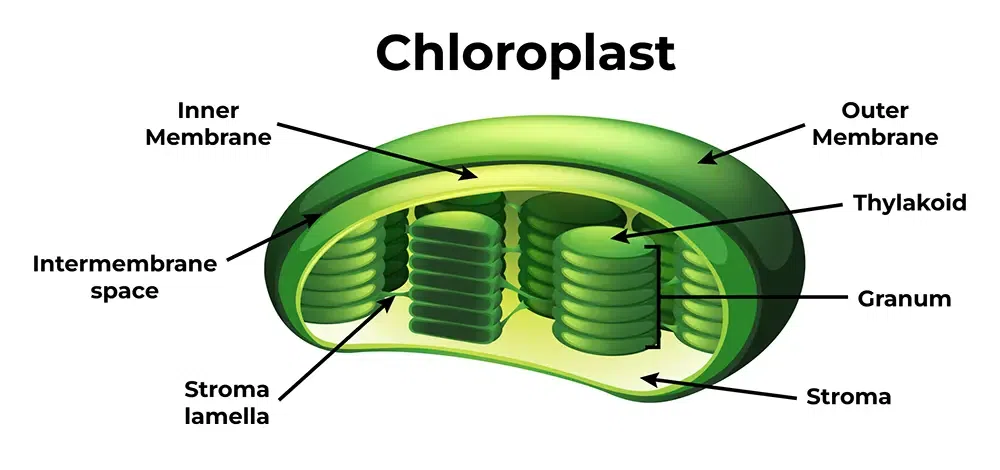
Ribosomes
particles made of ribosomal RNA and protein; carrys out protein synthesis in two locations 1). cytoplasm aka cytosol (free ribosomes) 2). outside the endoplasmic reticulum or nuclear envelope (bound ribosomes); uses the info from DNA to make proteins
Nucleus
contains most of the DNA in eukaryotic cells; has a nuclear membrane (envelope and nuclear pores; inside, the DNA and proteins form genetic material called chromatin which condenses to form discrete chromosomes

Nucleolus
inside nucleus, site of ribosomal RNA (rRNA) synthesis
Cell Membrane
selectively or semi-permeable which means it regulates what comes in/out the cell, composed of a double layer of phospholipids with proteins embedded throughout
Membrane-Bound Organelles
Endoplasmic reticulum
Mitochondria
Chloroplasts
Golgi
Nuclear envelope
Lysosomes
Vacuoles
Why Organelles?
Specialized structures with specialized functions like cilia or flagella for locomotion
Containers that partition cell into compartments to create different local environments like separate pH, or concentration of materials; distinct and incompatible functions like lysosome and its digestive enzymes
Membranes as sites for chemical reactions: unique combinations of lipids and proteins, embedded enzymes and reaction centers, membranes provide more surface area for reactions like chloroplasts and mitochondria
Smooth Endoplasmic Reticulum
Membrane production
Many metabolic processes: Synthesis (synthesize lipids like oils, phospholipids, steroids & sex hormones); Hydrolysis (hydrolyze glucogen into glucose in liver; detoxify drugs & poisons in liver via alcohol & barbiturates)
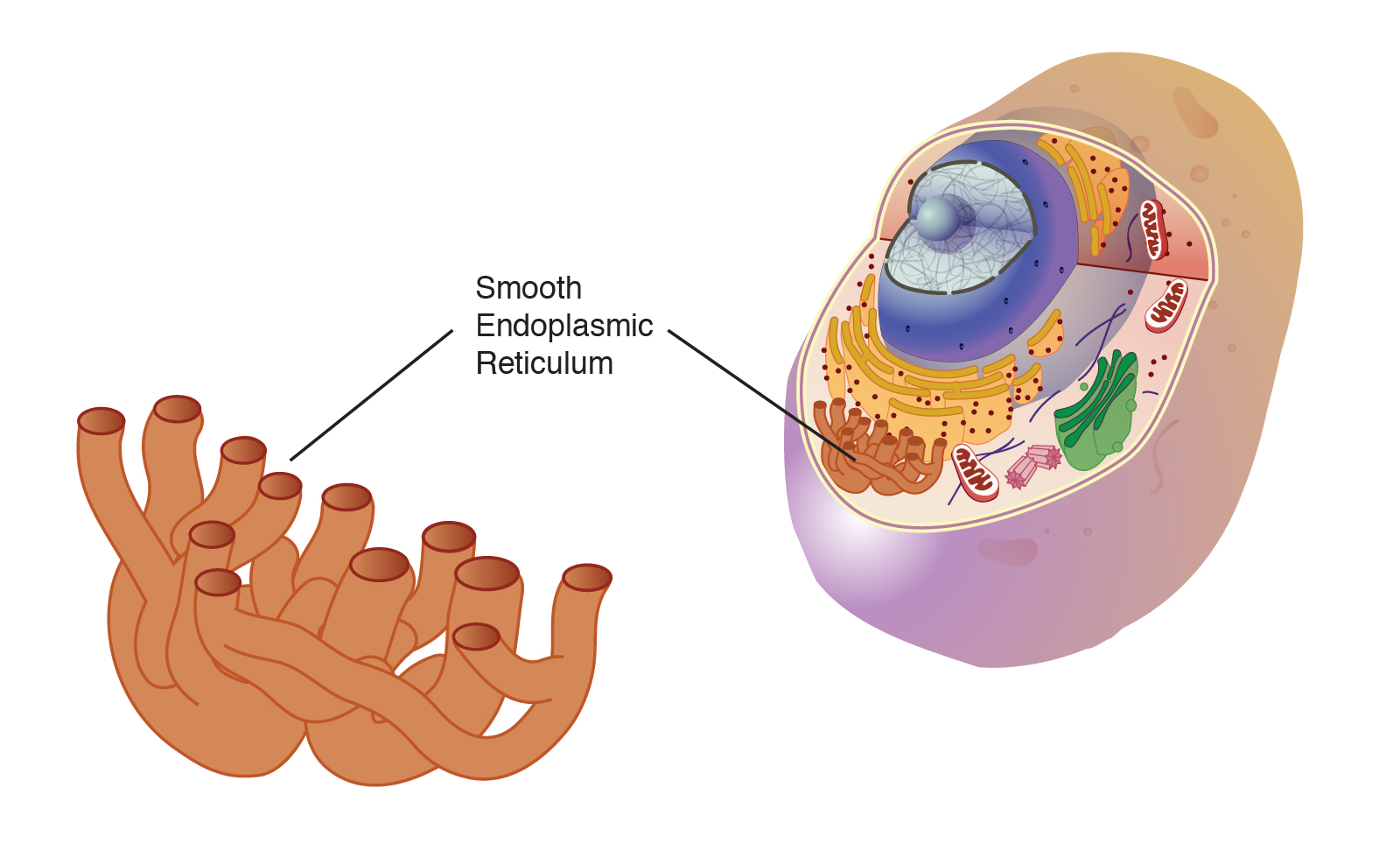
Rough Endoplasmic Reticulum
processes proteins for export out of cell: protein secreting cells, packaged into transport vesicles for export

Membrane ASSEMBLY FAACTORYYY
Build new membrane
synthesize phospholipids/builds membranes
ER membrane expands: bud off & transfer to other parts of cell that need membranes
Ribosomes are where proteins are initially synthesized, the ER is a network where proteins and lipids are processed and transported, and the Golgi apparatus modifies, sorts, and packages these molecules for their final destinations.
the rough ER, covered in ribosomes, is the primary site for the synthesis and modification of proteins destined for the cell membrane or export. The smooth ER, lacking ribosomes, focuses on lipid synthesis, steroid production, and detoxification.
Golgi Apparatus
finishes, sorts, tags, and ships cell proteins like a “UPS shipping department”; ships products in vesicles like membrane sacs or “UPS Trucks”
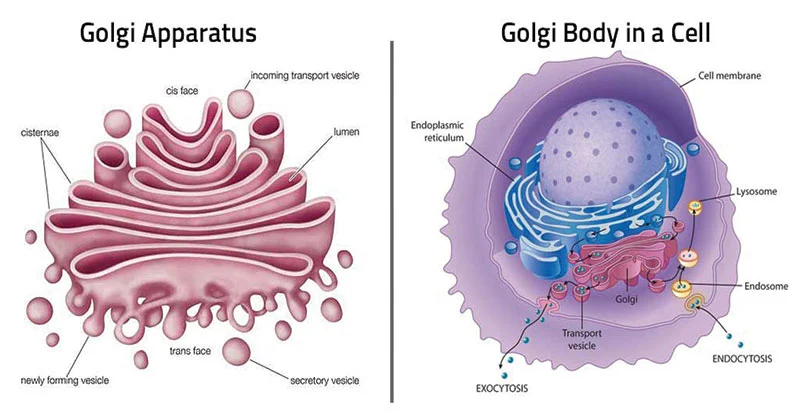
Lysosome
membranous sac of hydrolytic enzymes that can digest macromolecules
lysosomal enzymes can hydrolyze proteins, fats, polysaccharides, and nucleic acids
use enzymes to recycle the cell’s own organelles and macromolecules
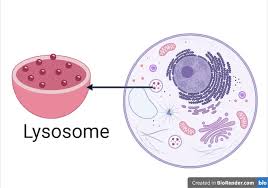
Vacuoles (Diverse Maintenance Compartments)
membrane bound storage sacs that serve multiple purposes
food vacuoles are formed by engulfing food
contractile vacuoles are found in many freshwater protists, and pump excess water out of cells
central vacuoles are found in many mature plant cells, hold organic compounds and water
In plant cells, it takes up a lottttt of space
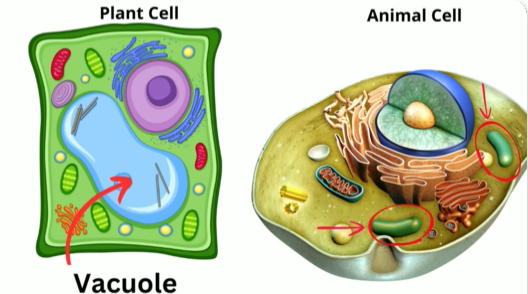
Mitochondria and Chloroplasts change energy from one form to another
not part of the endomembrane system
has double membranes
have proteins made by free ribosomes
contains their own DNA
Site of cellular respirations aka a metabolic process
Mitochondria since it generates ATP
Sites of photosynthesis and only found in plants and algae
Chloroplasts
Peroxisomes
oxidative organelles, specialized metabolic Compartments bounded by a single membrane, produce hydrogen peroxide and converts it into water, oxygen is used to break down different types of molecules
More about chloroplasts and how they capture light energy
member of a family of organelles called plastids
chloroplasts contain the chlorophyll (green pigment), and enzymes & other molecules that function in photosynthesis
found in leaves and other green organs of plants and algae
structure includes, thlykoids and membranous sacs that are stacked to form granum, and stroma aka internal fluid
Centrosomes
not in plant cells
plastids
not in animal cells, is in plant
Fluid Mosaic Model
fluid: membrane held together by weak interactions; mosaic: phospholipids, proteins, carbs
carbohydrates
cell-to-cell recognition
glycolipids, glycoproteins
ex, blood transfusions are type-specfic
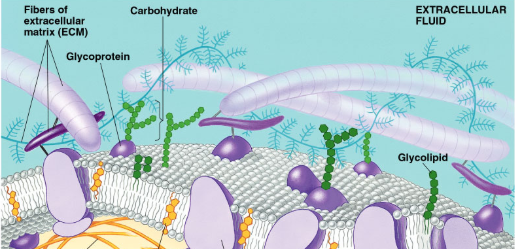
Phospholipids
bilayer
amphipathic = hydrophilic head, hydrophobic tail
hydrophobic barrier: keeps hydrophilic molecules out
Membrane fluidity
low temps: phospholipids w/ unsaturated tails (kinks prevent close packing)
High temps: increase phospholipid movement
cholesterol resists changes
adds firmness and integrity to cell membrane
prevents it from becoming overly fluid or overly firm
cellular membranes are fluid mosaics if lipids and proteins that are continuously moving in the bilayer
selective permeability
small molecules (polar or no polar) cross the lipid bilayer easily (hydrocarbons, hydrophobic molecules, CO2, O2)
hydrophobic core prevents passage of ions, large polar molcules (this is where proteins come in)
membrane
a collage of different proteins embedded in the fluid matrix of the lipid bilayer, proteins determine most of the membrane’s specific functions
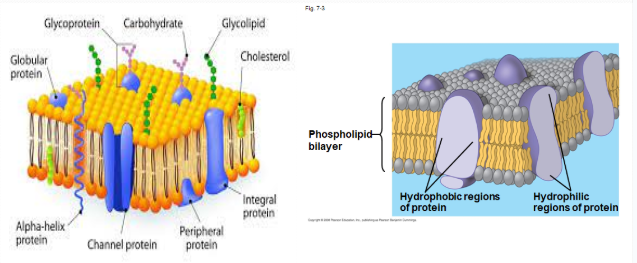
Peripheral proteins
bound to surface of membrane, extracellular/cytoplasmic sides of membrane, NOT embedded, held in place by cytoskeleton or ECM, provides stronger frame work
integral proteins
penetrate the hydrophobic core, the ones that span the membrane are called transmembrane proteins, embedded in membrane, transmembrane with hydrophilic heads/tails and hydrophobic middles
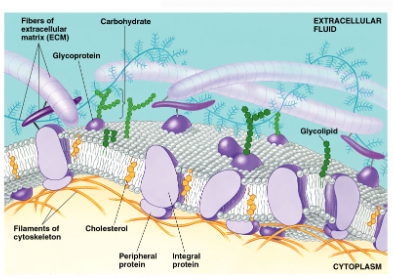
6 major functions of membrane proteins
transport
enzymatic activity
signal transduction
cell-cell recognition
intercellular joining
attachment to the cytoskeleton and extracellular matrix (ECM)

Transport proteins
concentration gradient (high to low?), diffusion of lipid-soluble substances, passive transport of water-soluble substances, active transport using ATP
Plants
has cell wall that cover their plasma membranes
extracellular structure (not found in animal)
provides shape/structure, protection, regulation of water intake
comprised of cellulose
thicker than plasma membranes
contain plasmodesmata: hole-like structures in the cell wall filled with fluid that connect adjacent cells
Cell Size and Scale
most cells are between 2µm and 200µm
A micrometer is 1 millionth of a meter!
Too small to be seen with naked eye
Limits on cell size
Cellular Metabolism
Diffusion -Movement of molecules from higher
concentration to lower concentration
A cell must be able to take in nutrients and take out waste
A cell 20 cm would require months for nutrients to get to the center
dissipate thermal energy (means to separate kinda)
Surface Area to Volume Ratio
Volume increase more rapidly than surface area.
When cell size doubles, the cell has 8x as much volume, but only 4x as much surface area
Small cells have a greater surface area relative to volume

Cell size rules
must be small to maintain a large surface area to volume ratio
Large S.A. allows ↑ rates of chemical exchange between cell and environment

cell facts
tend to be small
Small cells have a high SA:V ratio
Optimizes exchange of materials at the plasma membrane
Larger cells have a lower SA:V ratio
Lose efficiency exchanging materials
The cellular demand for resources increases
Rate of heat exchange decreases
what if cell is too fat (big)
it can:
Have a long thin shape
Fold the surface membrane
Divide
surface area example (animal)
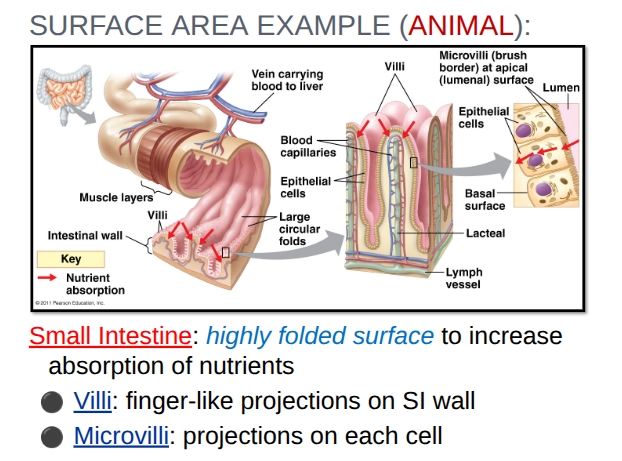
surface area example (plant)

passive transport
diffusion of a substance across a membrane with no energy (ATP) investment
diffusion down concentration or electrochemical gradient (high to low concentration)
involved in the import and export of waste (diffusion, osmosis, facilitated diffusion)
includes hydrocarbons, CO2, O2, H20
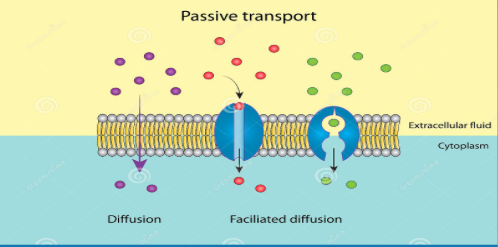
diffusion
tendency for molecules to spread out evenly into the available space
moves randomly put diffusion of a population may exhibit a next movement in one direction
at dynamic equalibrium, as many molecules cross one way as cross in the other directions
Substances diffuse down their concentration gradient, the difference in concentration of a substance from one area to another
No work must be done to move substances down the concentration gradient
The diffusion of a substance across a biological membrane is passive transport because it requires no energy from the cell to make it happen
The following influence the rate of diffusion
- Concentration gradient
- Temperature
- Surface area

Osmosis
diffusion of water across a selectively permeable membrane
Water diffuses across a membrane from the region of lower solute concentration to the region of higher solute concentration
maintaining water balance is crucial for the survival of all organisms

Equilibrium
rate of diffusion decreases once equilibrium is reached
net rate of diffusion is zero
definition: state in which the concentrations on both sides of the semi-permeable membrane are the same (equal)
External environments can be hypotonic, isotonic, or hypertonic to internal environments of cell

Hypertonic Solution
Solute concentration is greater than that inside the cell; cell loses water
Hyper= high...the solute is high in a solution
when the solute is high the water is low, the cell will shrivel or crenate

Tonicity (don’t have to read all)
ability of an extracellular solution to cause a cell to gain or lose water
Depends on the concentration of solutes that cannot pass through the cell membrane
Cells can be in three types of solutions: isotonic, hypertonic, hypotonic
Cells immersed in an isotonic solution have no net movement of water
The concentration of nonpenetrating solutes inside the cell is equal to that outside the cell.
Water diffuses into the cell at the same rate water moves out of the cell
Cells immersed in a hypertonic solution lose water to their extracellular surroundings
The concentration of nonpenetrating solutes is higher outside of the cell
Water will move to the extracellular fluid, Cells shrivel and die
Cells immersed in a hypotonic solution gain water
The concentration of nonpenetrating solutes is lower outside of the cell
The cell will gain water
Animal cells swell and lyse
Plant cells work optimally
Isotonic solution
Solute concentration is the same as that inside the cell; no net water movement across the plasma membrane; solute= solute
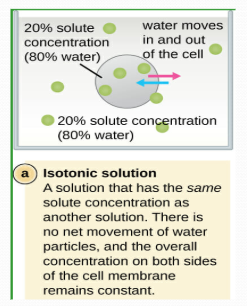
Hypotonic solution
Solute concentration is less than that inside the cell; cell gains water
Hypo= low...the solute is low in a solution
when the solute is low the water is high, the cell will swell and lyse

Hypertonic VS Isotonic VS Hypotonic Solutions
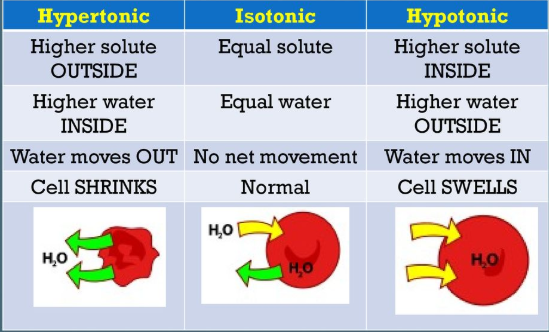
Facilitated diffusion
diffusion of molecules through the membrane via transport proteins
increases rate of diffusion for small ions, water, carbohydrates
2 groups of transport proteins: channel and carrier
each transport proteins is specific for substances it can facilitate movement for

Channel Proteins
provide a channel for molecules and ions to pass
hydrophlic
many are gated which means it only allows passage when there is a stimulus
aquaporins: specific channel protein for water
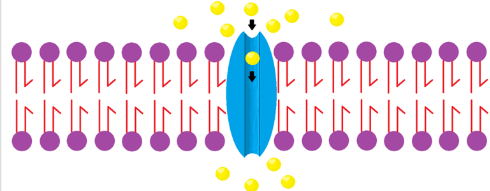
Carrier proteins
undergo conformational changes for substances to pass

Glucose transport Protein (carrier protein)

why isn’t energy required for facilitated diffusion
Energy is not required because the molecules are still moving down their concentration gradient
Osmoregulation
cells must be able to regulate their solute concentrations and maintain water balance
Animal cells will react differently than cells with cell walls, like plants, fungi, and some protists
maybe important..
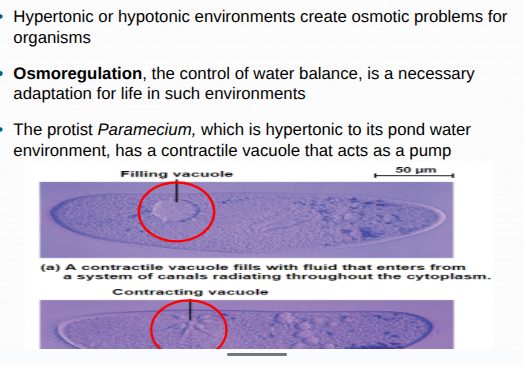
Turgid
firm, plant cells become this in hypotonic solutions as the swell until the wall opposes uptake
plant cell - isotonic
there is no net movement of water into the cell; the cell becomes flaccid (limp), and the plant may wilt
Plasmolysis
usually lethal effect, when a plant cell loses water (hypertonic environment), the membrane pulls away from the wall
difference between facilitated diffusion and diffusion
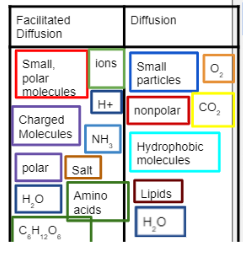
active transport
requires energy (atp)
performed by specific proteins embedded in the membranes
low-high concentrations
substances moving AGAINST the concentration gradient
examples: pumps, exo/endocytosis
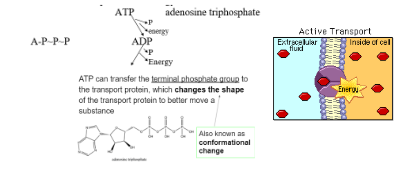
Pumps
maintain membrane potential
mp: voltage difference or unequal concentrations of ions across the membrane, resulting in an electrical charge; The cytoplasm is relatively negative in comparison to the extracellular fluid
Voltage is created by differences in the distribution of positive and negative ions
Two combined forces, collectively called the electrochemical gradient, drive the diffusion of ions across a membrane: A chemical force (the ion’s concentration gradient); An electrical force (the effect of the membrane potential on the ion’s movement)
ex, Electrogenic pumps: proteins that generate voltage across membranes, which can be used later as an energy source for cellular processes
Sodium potassium pump: Animal cells will regulate their relative concentrations of Na+ and K+, 3 Na+ get pumped out of the cell, 2 K+ get pumped into cell, Results in a +1 net charge to the extracellular fluid
electrogenic pump
a transport protein that generates voltage across a membrane
sodium-potassium pump
the major electrogenic pump of animal cells
Animal cells will regulate their relative concentrations of Na+ and K+, 3 Na+ get pumped out of the cell, 2 K+ get pumped into cell, Results in a +1 net charge to the extracellular fluid
Proton pump
the main electrogenic pump of plants, fungi, and bacteria, pumps H+ out of cell
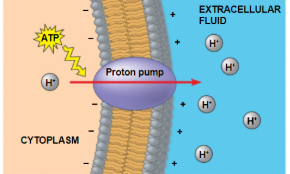
Bulk transport
occurs by exocytosis and endocytosis
Small molecules and water enter or leave the cell through the lipid bilayer or by transport proteins
Large molecules, such as polysaccharides and proteins,or other cells cross the membrane in bulk via vesicles
Bulk transport requires energy
exocytosis
transport vesicles migrate to the membrane, fuse with it, and release their contents
Many secretory cells use exocytosis to export their products (ex: nerve cells releasing neurotransmitters)
vesicles fuse with cell membrane, expel contents

endocytosis
the cell takes in macromolecules by forming vesicles from the plasma membrane
Endocytosis is a reversal of exocytosis, involving different proteins
There are three types of endocytosis:
Phagocytosis (“cellular eating”)
Pinocytosis (“cellular drinking”)
Receptor-mediated endocytosis
take in macromolecules, form new vesicles
Phagocytosis
a cell engulfs a particle in a vacuole
The vacuole fuses with a lysosome to digest the particle
think “cellular eating” - solids
Ex: white blood cell eating bacteria,Ameba eating another cell

pinocytosis
molecules are taken up when extracellular fluid is “gulped” into tiny vesicles, think “cellular drinking” - fluids
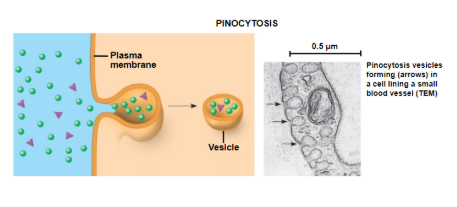
receptor-mediated endocytosis
binding of ligands to receptors triggers vesicle formation on cell surface

ligands
any molecule that binds specifically to a receptor site of another molecule